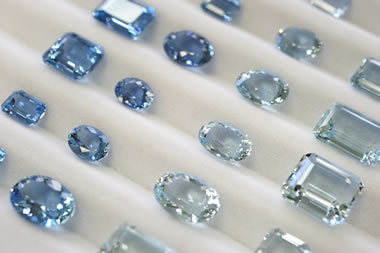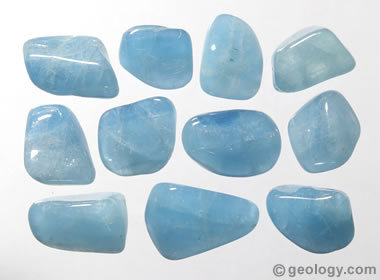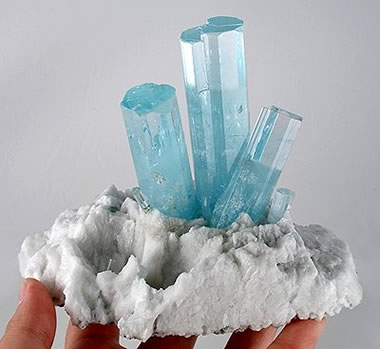Aquamarine
A popular blue gemstone and birthstone for the month of March.
Author: Hobart M. King, PhD, GIA Graduate Gemologist

Faceted Aquamarine: The blue color of aquamarine ranges from a blue color that is so faint that it is almost imperceptible to a blue color that is rich and vibrant. There is an enormous difference in price between a stone with a faint blue color and a similar stone with a vibrant blue color. Shop with that in mind. Many people find a stone that fits their budget in the middle of the color range. Image copyright iStockphoto / dolphinphoto.
What is Aquamarine?
Aquamarine is the name used for gem-quality specimens of the mineral beryl within a color range of greenish blue to blue. The name is used regardless of a stone's tone or saturation. So, aquamarines can range from a very light, almost imperceptible color to stones with a rich vibrant color.
Most aquamarine has a very light color, which can be almost unnoticeable in very small stones. Stones with a rich blue color are the most popular. They are also the rarest and most valuable.
The name aquamarine is derived from a combination of two Latin words: aqua, meaning water, and marina, meaning the sea - the color of the sea. [1]
Table of Contents

March Birthstone: Aquamarine serves as a birthstone for the month of March. A few months give people a choice of more than one birthstone and March is one of those months. People born in March can select a faceted aquamarine or they can select a cabochon-cut bloodstone.
Aquamarine: March Birthstone
Many people know aquamarine because it serves as the birthstone for the month of March. Aquamarine rings, earrings, and pendants are popular birthstone gifts.

Beryl Beads: This bracelet is made of translucent aquamarine and translucent morganite beads that are 8-millimeters in diameter. Translucent can be beautiful!

Tumbled Aquamarine: These tumbled stones were made from translucent aquamarine. They have a wonderful color. They range from 3/4" to 1 1/8" in length.
Aquamarine: Transparent and Translucent
Aquamarine is best known as a highly transparent blue stone. Unlike emerald, the deep green variety of beryl, high-clarity, fracture-free aquamarine is abundant and more affordable. High-clarity, fracture-free stones are also more attractive and less likely to be damaged during wear.
Did you know that nice pieces of translucent aquamarine are also used in jewelry? Translucent aquamarine is often cut into beads and sometimes cut as cabochons. Necklaces strung with beads of pastel blue aquamarine and pastel pink morganite (both color-varieties of the mineral beryl) make a beautiful combination.
We wondered what the gem identification experts at the Gemological Institute of America (GIA) would think of a humble tumbled stone made from translucent blue beryl. So, we packed one up and submitted it to their lab for identification.
We were delighted to see that despite its distinctly translucent clarity and modest cutting style, the GIA lab identified it as follows... Species: natural beryl, Variety: aquamarine. [2] The identity of the stone was based upon mineral species and color. Clarity and shape did not influence its identity.
Physical Properties of Aquamarine |
|
| Chemical Classification | Silicate |
| Color | Greenish blue to blue (color almost always has been improved by heat treatment) |
| Streak | Colorless (harder than the streak plate) |
| Luster | Vitreous |
| Diaphaneity | Translucent to transparent |
| Cleavage | Imperfect |
| Mohs Hardness | 7.5 to 8 |
| Specific Gravity | 2.6 to 2.8 |
| Diagnostic Properties | Crystals are prismatic, often with flat terminations, hexagonal, and without striations. Hardness and relatively low specific gravity. |
| Chemical Composition | Be3Al2Si6O18 |
| Crystal System | Hexagonal (often occurs in prismatic to tabular crystals with a hexagonal cross section) |
| Uses | Aquamarine has a hardness and durability that makes it suitable for all jewelry uses. |
Aquamarine Gemology
Aquamarine is such a popular gemstone that it can be found in almost any jewelry store in the United States. If you are interested in purchasing an item of aquamarine jewelry, here are a few things to consider:
Durability: Aquamarine has a Mohs hardness of 7.5 to 8, making it one of the harder gemstones. Diamond, ruby, sapphire, topaz, and chrysoberyl are the only popular gemstones that are significantly harder. Hardness is a property that enables a gem to resist scratching. However, aquamarine's tenacity is rated as brittle - which means that the gem can be easily chipped upon impact. A mounting that guards the stone from impact and not wearing the gem during activities that might result in accidental impact are important precautions.
Color: The price of aquamarine is mainly determined by weight and the strength of its color. Gems with a faint blue color are abundant and inexpensive. Gems with a rich blue color are much more expensive because rich color in aquamarine is very rare. A small aquamarine with a rich blue color will cost a lot more than identical-size stones with a faint blue color.
Size: Aquamarine is available in a wide range of sizes. As the size of the gem increases, the strength of its apparent color will also increase. It can be difficult to find a small gem with a rich blue color, but as the size of the stone increases, the opportunity to find strong color also increases.

Heat-Treated Aquamarine: The blue color of this 0.52-carat faceted aquamarine from Madagascar was improved by heat treatment.
Aquamarine Color and Treatment
As a member of the beryl mineral family, aquamarine has a chemical composition of Be3Al2Si6O18. Pure beryl is colorless. The greenish blue to blue color of aquamarine is caused by trace amounts of iron.
The iron can occur in two oxidation states. Ferrous iron (Fe2+) is responsible for blue color, and ferric iron (Fe3+) is responsible for yellow color (which combines with the blue color to produce greenish blue). [3]
Most natural aquamarine has a greenish blue color. Gentle heat treatment can remove the yellow color and transform the gem's color to a more pure and more valuable blue.
Greenish yellow and other colors of beryl can be altered to colors within the aquamarine range by heat treatment. [3] Most of the aquamarine offered for sale in today's market has received heat treatment. The color improvements achieved by heat treatment are thought to be permanent and undetectable by current methods of testing.
Any time a gem has been heated, irradiated, dyed, or undergone other treatments to improve its color, durability or appearance, the seller should disclose that information to the buyer. This information is important to many buyers - even to buyers of low-cost items.
Maxixe: The Other Blue Beryl
Maxixe (pronounced "mashish") is a rare variety of beryl with a dark blue color. The blue color develops while the gem material is still within the Earth by exposure to natural radiation. Unfortunately, the blue color gradually fades to a pale brownish color upon exposure to light. If Maxixe loses its color, it can be irradiated in a laboratory; however, the renewed blue color will also fade.
Maxixe can be separated from aquamarine in the following ways:
1) by its pleochroism (the strongest pleochroic color of maxixe is seen when the maxixe crystal is viewed down its c-axis, but in aquamarine the strongest blue color is seen when viewing the crystal perpendicular to the c-axis),
2) by its response under an ultraviolet lamp (some maxixe will glow a greenish color under both short- and long-wave ultraviolet radiation), and,
3) a lack of iron in its chemical composition (The iron content test will not be reliable for specimens of synthetic aquamarine which have received their blue color from cobalt or another chromophore.)
These tests can also be used to separate synthetic maxixe (also known an maxixe-type beryl) from synthetic aquamarine. [6]
Synthetic Aquamarine
Synthetic aquamarine (lab-grown aquamarine) has been produced by hydrothermal growth methods in Russia since at least the 1980s [4] and since the early 2000s in the Czech Republic [5].
Some synthetic aquamarine receives its color from iron, like natural aquamarine. However, richly colored synthetic aquamarine has been produced using cobalt, copper, and nickel as sources of color. These metals have not been found as sources of color in natural aquamarine. [4]
Much synthetic aquamarine can be separated from natural aquamarine by microscopic examination. However, the growth zoning structures used to identify synthetic aquamarine are more difficult to recognize, especially in light-colored material. Characteristic mineral inclusions and multiphase inclusions can be used to identify natural aquamarine. [6]
It is unusual to see jewelry items disclosed as synthetic aquamarine, lab-grown aquamarine, or other man-made descriptors. These materials may be uncommon in the marketplace or are simply sold without disclosure.

Aquamarine Crystals: Beautiful aquamarine crystals growing on a base of feldspar from the Skardu District of Pakistan. Prismatic crystals with a hexagonal cross-section and a flat termination is a common aquamarine habit. The specimen is approximately 14 x 12 x 7.5 centimeters in size. Specimen and photo by Arkenstone / www.iRocks.com.
Geological Occurrence
Most gem-quality aquamarine crystals form in cavities below Earth's surface during the late stages of a magma body's crystallization. The cavities provide open space for crystals to grow. The slow underground cooling rate provides the time needed for the development of large crystals. And, the late-stage timing provides the fluids and a supply of the beryllium needed to form beryl, a beryllium mineral.
Aquamarine is usually found in granite pegmatites. Another source is from veins in metamorphic rocks that were mineralized by hydrothermal activity.
If rocks containing aquamarine are exposed by weathering and erosion, the exceptional hardness of aquamarine (7.5 to 8 on the Mohs scale) will cause it to persist in overlying soils and stream sediments. Much aquamarine has been produced from stream sediments. Where it is found in stream sediments suggests that a primary deposit is located upstream.
| Aquamarine References |
|
[1] Aquamarine History and Lore: an article on the Gemological Institute of America website, accessed July 2020.
[2] Gemstone Identification Report: prepared by the Gemological Institute of America Laboratory, November 2017. [3] Aquamarine Gemstone Information: an article on the AJS Gems website, accessed July 2020. [4] Hydrothermally Grown Synthetic Aquamarine Manufactured in Novosibirsk, USSR: by Karl Schmetzer; Gems and Gemology, Volume 26, Number 3, pages 206 to 211, Fall 1990. [5] Synthetic Gem Materials in the 2000s: by Nathan Renfro, John I. Koivula, Wuyi Wang, and Gary Roskin; Gems and Gemology, Volume 46, Number 4, pages 260 to 273, Winter 2010. [6] Aquamarine, Maxixe-Type Beryl, and Hydrothermal Synthetic Blue Beryl: Analysis and Identification: by Ilaria Adamo, Alessandro Pavese, Loredana Prosperi, Valeria Diella, David Ajò, G. Diego Gatta, and Christopher P. Smith; an article in Gems & Gemology, Volume 44, Number 3, pages 214 to 225, Fall 2008. |
Sources of Aquamarine
Brazil is the world's leading source of gem-quality aquamarine for over 100 years. It is found there in both pegmatites and alluvial deposits. Afghanistan, Kenya, Madagascar, Malawi, Mozambique, Nigeria, Pakistan, Russia, Tanzania, and Zambia are all sources of aquamarine. India and Sri Lanka have long histories of aquamarine production from alluvial deposits.
Aquamarine has been found at many locations in the United States. To date, almost all of the production has been from small-scale mining, often where multiple minerals are being produced.
| More Gemstones |
 |
Tourmaline |
 |
Fancy Sapphires |
 |
Diamond |
 |
Canadian Diamond Mines |
 |
Birthstones |
 |
Pictures of Opal |
 |
Fire Agate |
 |
Blue Gemstones |

Find Other Topics on Geology.com:

|

| ||

|

| ||

|

| ||

|

|

